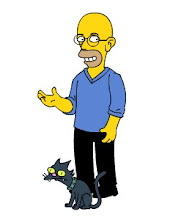Back once more for another tour of Edinburgh's dark underbelly with Inspector Rebus' sixth outing, Mortal Causes.
Set against the backdrop of Edinburgh's annual arts festival, the novel opens with an murder in a vault off one of the city's ancient, subterranean streets. Elements of the murder, a brutal knee-capping ended with a headshot, remind Rebus of the punishment beatings he witnessed years earlier in Northern Ireland, and raises the spectre of terrorist activity spilling into the British mainland. Worse, when the victim is identified, he turns out to be no less than the son of "Big Ger" Cafferty, an Edinburgh kingpin with more than a passing interest in Rebus.
This apparent linkage of Edinburgh's criminal underworld with Northern Irish sectarianism leads to Rebus' secondment into a specialist crime squad with links to London's Special Branch. While this affords Rebus certain opportunities to advance the case, it also makes him the "new boy" in an already suspicious team. However, Rebus keeps a hand in with the investigations of old squad with help from his trusty underlings, DS Holmes and DS Clarke. Their work, together with information from Rebus' shady contacts in Edinburgh's criminal fraternity, leads to the unearthing of a connection to a seemingly defunct Scottish nationalist group, the Sword and Shield, that seems to have gained a new lease of life, one that involves the supply of weapons to Protestant "brothers" in Ulster. These developments lead Rebus to confront the sectarian elements of his own home town and, along the way, complicate his relationship with Big Ger.
It's already getting repetitive to say it, but with each novel Rankin is getting more and more sure-footed with Rebus, and Mortal Causes is definitely the high point to date. While tantalisingly labyrinthine, the plot uncoils effortlessly, with a nice number and balance of slowly interconnecting threads. By now, Rankin has established his roster of characters well enough that they need no introductions, and appear satisfyingly well-rounded because of the "baggage" carried over from earlier titles. Even sporadic characters such as Rebus' stuffy superior, 'Farmer' Watson, have become amiably familiar figures for whom even brief appearances now convey far more than the bare words might suggest.
One particularly interesting aspect of this novel for me was its extensive coverage of sectarianism in Scotland. In what now seems surprising to me, growing up there I was almost completely unaware of this side of Scottish life. Part of this can probably be attributed to me being on the east coast, and in a town where Catholics were too thin on the ground to inspire any comment (not, of course, that the absence of non-white people led to any corresponding drop-off in racism). Until I was well into my teens, all I knew about Catholics was that they were exactly the same as everyone else but went to a different church for Christmas and Easter services. Subsequently, I became a lot more aware of how divisive Catholicism is for a section of Scotland's Protestant population, including, as it happens, my Bothwell-residing "Uncle" Willy. But by the time I came to first came to grips with this nonsense, I was already irredeemably dismissive of all such sectarian splits. And having now been in England for years, where such divisions seem even less noticeable than in Carnoustie, it all seems even more distant and irrelevant. So the novel was quite an interesting reminder of aspects of Scotland that, while diminished, haven't yet entirely withered.
Anyway, I'm now up to number 6 of the series, so slightly passed the third stage. Though only in terms of novels that is, by page count I'm nowhere near - they just get thicker and thicker!
Saturday 29 January 2011
Thursday 27 January 2011
Corporate whores
There are many reasons to dislike our current ConDem government, but one that to first glance seems less important has really underscored things for me. Going after the BBC World Service, essentially trimming its coverage of world languages, is an absurd foot-shooting exercise that can only diminish both the availability of quality news coverage to parts of the world that desperately need it, and erode the UK's soft power. But an entirely predictable one given Tory love for NewsCorp, and their Pavlovian prejudice against the BBC. They're not up with the Republicans in terms of shameless fawning to corporate media interests, but they're showing some alarming parallels. Would Thatcher have been so cowed by, and compliant to, such vested interests?
Palestinian Leaks
It seems to be something in the air at the moment. Though not mediated by Wikileaks this time, this past week's leaking of papers concerning Palestinian diplomacy have been highly instructive. However, not, I would argue, because of the reaction they've caused, but rather because of what's largely going unsaid about them.
Media attention has focused on the understandable reaction of the Palestinian public to news of just how far their leaders have been prepared to go to achieve a settlement with the Israelis. Which makes sense given the frankly surprising terms the authorities were proposing.
Much more significant to my mind, and much less remarked upon, is how these negotiations expose the towering intransigence of the Israelis. If they won't accept even these outrageously generous terms, what will they accept? The simple answer, which I've long believed to be the case, is that they are neither negotiating in good faith nor have the slightest interest in dealing with the UN-recognised fallout that their state's creation has resulted in.
Further, there seems to be very little comment on how this paints western powers, such as the US, who appear, in their support for the ostensibly democratic Israel, happy propping up a occupying power with no interest in human rights or justice.
Not, sadly, that this comes as any surprise. But will things change when the bad faith of the Israelis has been so prominently unveiled? I shan't be holding my breath.
Media attention has focused on the understandable reaction of the Palestinian public to news of just how far their leaders have been prepared to go to achieve a settlement with the Israelis. Which makes sense given the frankly surprising terms the authorities were proposing.
Much more significant to my mind, and much less remarked upon, is how these negotiations expose the towering intransigence of the Israelis. If they won't accept even these outrageously generous terms, what will they accept? The simple answer, which I've long believed to be the case, is that they are neither negotiating in good faith nor have the slightest interest in dealing with the UN-recognised fallout that their state's creation has resulted in.
Further, there seems to be very little comment on how this paints western powers, such as the US, who appear, in their support for the ostensibly democratic Israel, happy propping up a occupying power with no interest in human rights or justice.
Not, sadly, that this comes as any surprise. But will things change when the bad faith of the Israelis has been so prominently unveiled? I shan't be holding my breath.
Sunday 23 January 2011
This is not a promotion
We got a pleasant surprise yesterday during a visit to our local Kwik-fit. We've had a slow puncture the last few weeks, and took the car in to get this fixed. Much to our surprise, they fixed the puncture, showed us the piece of tubular metal that was deflating our tyre, and then refused to charge us for their work. Presumably this is some sort of loss-leader, but it still came as a very pleasant surprise.
From science to science fiction
There's a long, and frequently noble, tradition of scientists getting imaginative on the side and cranking out works of science fiction alongside their formal research. Some of the genre's most significant writers in the 20th century, such as Isaac Asimov and Arthur C. Clarke, have done exactly this. And the tradition continues in the present day with authors such as Gregory Benford and (blog-favourite) Alastair Reynolds, and in the science journal Nature's Futures column.
Less well-remembered for his science fiction (at least by me), surprisingly so given his status as a scientist, is the Yorkshire-born astronomer and mathematician, Fred Hoyle. Known today largely for his pioneering work on nucleosynthesis and his dismissive christening of the "big bang", he also took time out to write science fiction, and C was kind enough to buy me one of his works, The Black Cloud, for my birthday. Curiously, although Hoyle's pronouncements on evolutionary biology feature as a recurring target in the books of Richard Dawkins, the latter is also a fan of his science fiction, and contributes an afterword to this edition.
Set in the then-future of 1964, the novel begins in California, where a graduate student looking for variable stars using successive photographic plates finds a patch of stars in the sky that simultaneously wink out. Further investigation using older plates of the same region of the sky finds that something is blotting out distant stars, and that this object is travelling towards our solar system. Meanwhile, over in Britain, an amateur astronomer looking at the outer planets finds them to be slightly displaced from their predicted orbits. After initial scepticism is dispelled by further observations, scientists calculate the position and size of the mass responsible, then contact their American colleagues to confirm its existence and nature.
Realising the enormous significance of their separate findings, the British and American scientists meet to consolidate their work and to forecast the path of this unidentified object through the solar system. Though their predictions are incomplete, they suggest that the Earth may be "blacked out" for a month as the diffuse "cloud" passes through the solar system. During this time, sunlight will be completely blocked, and temperatures will rise or fall dependent on the ambient temperature of the cloud. With only 18 months until the cloud passes by the Earth, both groups of scientists endeavour to persuade their respective governments of its significance, and the need to both improve observation of the cloud, and to put measures in place to save lives during the "blackout".
Aided by a scientifically literate government advisor, the British scientists are successful in their persuasive efforts, and a research centre-cum-shelter is established in Yorkshire. Here, further work refines the estimated path of the cloud, and determines its effects on the climate of the Earth. However, as the cloud continues to approach the Earth, its path deviates from that expected, and it appears to settle into orbit around the Sun. This causes significant, and deadly, consequences on Earth, with widespread crop failure and mass human mortality. Though the British scientists are baffled by the cloud's behaviour, they continue to study it and gradually refine their predictions of its future and, more importantly, that of the Earth.
However, during routine probing of the cloud's density with radio waves, repeatable patterns of interference occur in which the cloud appears to "respond" by blocking signals. To the incredulity of his colleagues, the lead British scientist proposes that the cloud is intelligent, and attempts to communicate with it by broadcasting the contents of an encyclopaedia at it. To the surprise of most of the scientists, this elicits a response from the cloud, and a dialogue begins. Through this, the scientists learn of the cloud's ancient and distant origin, of it being just one of a vast number of similar intelligences, and of its surprise that something as dense and unpromising as a planet could produce and nurture intelligent life. As news of the cloud's nature spreads to other governments, several take military action against it for the calamity caused, launching nuclear weapons that, after a warning from the British scientists, are batted back toward their launch sites by the cloud. While this strains the relationship with the cloud, it comes to understand the alien division of authority on Earth.
Then, almost as swiftly as it arrived, the cloud announces that, contrary to its initial plan to orbit the Sun for years, it is to depart for another star. A distant "eureka!" moment by one of its fellow intelligences requires immediate investigation. However, in leaving, the cloud arranges for its passage to disrupt the Earth's climate as little as possible. The British scientists, stunned that they will now be unable to quiz the cloud on matters of science, scramble to obtain a primer from the cloud. However, the cloud warns them that its understanding of the universe is too sophisticated to convey easily or safely, and in pressing on, two of the scientific team, including its leader, succumb to the "overload" of information from the cloud. The novel concludes with a descendant of the scientific team passing on the subsequently suppressed knowledge of the cloud's intelligence, in the hope that later generations might try to contact it.
Whew, I seem to have gotten a bit carried away there, and have done the whole plotline for once. Anyway, was a giant of science also a giant of science fiction? Yes and no. Overall it's a pretty good yarn, told pretty well. For almost all of the book Hoyle does a great job gradually ramping up the story with logical and scientifically sensible steps forward. If there's a weakness, it's that the cloud's true nature is revealed really rather late in the novel, leaving this most important revelation relatively few pages to be covered in. While it means that Hoyle is able to conclude with the cloud's mysterious nature largely intact, the latter portion of the novel does seem a little rushed relative to the carefully-paced first two-thirds. Especially so given Hoyle's deus ex machina that sees the cloud suddenly decide to leave our solar system. This does make for a glimmer of an interesting insight into the activities of the cloud intelligences, but it also seems like a barefaced drive to wrap up the novel.
Another angle that's enjoyable is Hoyle's portrait of post-war science and the (exclusively male) scientists who populate it. Though things have changed since then, it's still a recognisable place to me, if a little more slowly-paced (and patronising to women). Hoyle also does a nice job of squeezing some science into the tale without the novel reading like it's artlessly plagiarised a textbook. So we get introductions to studying star variability, a stealthy primer on orbital mechanics and some rough-and-ready climatology as the cloud gradually approaches the Earth. There are also some really clever points made along the way like, for instance, when the idea of communicating with the cloud is first mooted. Some of the scientists rightly question whether they'll be able to translate its messages, but the lead scientist notes that, if the cloud is as intelligent as he supposes, it can easily make itself understood to them rather than the other way round.
Aspects that are more unexpected are how easily the scientists are able to set themselves up as an autonomous community that largely escapes government control. It may just be that I've read too many books, and seen too many films, in which the scientists are tightly reined-in by heavy-handed government authorities. And I didn't entirely buy the "brain overload" thread at the end of the novel. Something as intelligent as the cloud, an entity that quickly comes to understand humanity, would surely be able to give a dummy's guide to its scientific understanding rather than presenting it in one big chunk that melts brains. This felt like a cheesy "beyond the ken of man" moment from some 1950s B-movie.
One final point I can't let slip passed is the characterisation. It's not exactly a story that requires finely-detailed characters, but Hoyle's scientists are largely distinguishable from one another, even if they are cut a bit from the same "can-do-spirit" cloth. And he does fumble a bit with the non-scientist characters, who seem to be sketched in more as comic relief at times. His lead scientist, while painted as highly intelligent, isn't made particularly likeable. Hoyle seems happy to have someone the reader struggles a bit to empathise with. Another interesting thing, which is very much of its time, is the belief of the characters (= Hoyle) that humanity's future would best be served by a technocracy of intelligent (male) scientists. In part, this is conveyed passively by the novel, as the scientists amusingly "get one over" on the government when setting up their remote base. But the characters are occasionally more vocal in articulating this view, something that would seem very odd in this day and age. These days, I think that most scientists, while happy to point out endless government failures to pay attention, would baulk at the idea of putting themselves in power. While chastising them, I think scientists now better appreciate the difficulty that governments face in satisfying both scientific concerns and public interest.
Overall, it's easy to recommend the book. Both for its science fiction aspects, but also for how it portrays life in science in the 1950s. The latter I'd not expected Hoyle to make so interesting.
P.S. I forgot to note that, when the cloud explains its great age in the novel, Hoyle can't resist taking the opportunity to bash the big bang, then a relatively new idea but subsequently his lifelong bête noire. While I already knew of Hoyle's misgivings, it was still amusing to see him taking such a scientific pot shot in his first novel.
Less well-remembered for his science fiction (at least by me), surprisingly so given his status as a scientist, is the Yorkshire-born astronomer and mathematician, Fred Hoyle. Known today largely for his pioneering work on nucleosynthesis and his dismissive christening of the "big bang", he also took time out to write science fiction, and C was kind enough to buy me one of his works, The Black Cloud, for my birthday. Curiously, although Hoyle's pronouncements on evolutionary biology feature as a recurring target in the books of Richard Dawkins, the latter is also a fan of his science fiction, and contributes an afterword to this edition.
Set in the then-future of 1964, the novel begins in California, where a graduate student looking for variable stars using successive photographic plates finds a patch of stars in the sky that simultaneously wink out. Further investigation using older plates of the same region of the sky finds that something is blotting out distant stars, and that this object is travelling towards our solar system. Meanwhile, over in Britain, an amateur astronomer looking at the outer planets finds them to be slightly displaced from their predicted orbits. After initial scepticism is dispelled by further observations, scientists calculate the position and size of the mass responsible, then contact their American colleagues to confirm its existence and nature.
Realising the enormous significance of their separate findings, the British and American scientists meet to consolidate their work and to forecast the path of this unidentified object through the solar system. Though their predictions are incomplete, they suggest that the Earth may be "blacked out" for a month as the diffuse "cloud" passes through the solar system. During this time, sunlight will be completely blocked, and temperatures will rise or fall dependent on the ambient temperature of the cloud. With only 18 months until the cloud passes by the Earth, both groups of scientists endeavour to persuade their respective governments of its significance, and the need to both improve observation of the cloud, and to put measures in place to save lives during the "blackout".
Aided by a scientifically literate government advisor, the British scientists are successful in their persuasive efforts, and a research centre-cum-shelter is established in Yorkshire. Here, further work refines the estimated path of the cloud, and determines its effects on the climate of the Earth. However, as the cloud continues to approach the Earth, its path deviates from that expected, and it appears to settle into orbit around the Sun. This causes significant, and deadly, consequences on Earth, with widespread crop failure and mass human mortality. Though the British scientists are baffled by the cloud's behaviour, they continue to study it and gradually refine their predictions of its future and, more importantly, that of the Earth.
However, during routine probing of the cloud's density with radio waves, repeatable patterns of interference occur in which the cloud appears to "respond" by blocking signals. To the incredulity of his colleagues, the lead British scientist proposes that the cloud is intelligent, and attempts to communicate with it by broadcasting the contents of an encyclopaedia at it. To the surprise of most of the scientists, this elicits a response from the cloud, and a dialogue begins. Through this, the scientists learn of the cloud's ancient and distant origin, of it being just one of a vast number of similar intelligences, and of its surprise that something as dense and unpromising as a planet could produce and nurture intelligent life. As news of the cloud's nature spreads to other governments, several take military action against it for the calamity caused, launching nuclear weapons that, after a warning from the British scientists, are batted back toward their launch sites by the cloud. While this strains the relationship with the cloud, it comes to understand the alien division of authority on Earth.
Then, almost as swiftly as it arrived, the cloud announces that, contrary to its initial plan to orbit the Sun for years, it is to depart for another star. A distant "eureka!" moment by one of its fellow intelligences requires immediate investigation. However, in leaving, the cloud arranges for its passage to disrupt the Earth's climate as little as possible. The British scientists, stunned that they will now be unable to quiz the cloud on matters of science, scramble to obtain a primer from the cloud. However, the cloud warns them that its understanding of the universe is too sophisticated to convey easily or safely, and in pressing on, two of the scientific team, including its leader, succumb to the "overload" of information from the cloud. The novel concludes with a descendant of the scientific team passing on the subsequently suppressed knowledge of the cloud's intelligence, in the hope that later generations might try to contact it.
Whew, I seem to have gotten a bit carried away there, and have done the whole plotline for once. Anyway, was a giant of science also a giant of science fiction? Yes and no. Overall it's a pretty good yarn, told pretty well. For almost all of the book Hoyle does a great job gradually ramping up the story with logical and scientifically sensible steps forward. If there's a weakness, it's that the cloud's true nature is revealed really rather late in the novel, leaving this most important revelation relatively few pages to be covered in. While it means that Hoyle is able to conclude with the cloud's mysterious nature largely intact, the latter portion of the novel does seem a little rushed relative to the carefully-paced first two-thirds. Especially so given Hoyle's deus ex machina that sees the cloud suddenly decide to leave our solar system. This does make for a glimmer of an interesting insight into the activities of the cloud intelligences, but it also seems like a barefaced drive to wrap up the novel.
Another angle that's enjoyable is Hoyle's portrait of post-war science and the (exclusively male) scientists who populate it. Though things have changed since then, it's still a recognisable place to me, if a little more slowly-paced (and patronising to women). Hoyle also does a nice job of squeezing some science into the tale without the novel reading like it's artlessly plagiarised a textbook. So we get introductions to studying star variability, a stealthy primer on orbital mechanics and some rough-and-ready climatology as the cloud gradually approaches the Earth. There are also some really clever points made along the way like, for instance, when the idea of communicating with the cloud is first mooted. Some of the scientists rightly question whether they'll be able to translate its messages, but the lead scientist notes that, if the cloud is as intelligent as he supposes, it can easily make itself understood to them rather than the other way round.
Aspects that are more unexpected are how easily the scientists are able to set themselves up as an autonomous community that largely escapes government control. It may just be that I've read too many books, and seen too many films, in which the scientists are tightly reined-in by heavy-handed government authorities. And I didn't entirely buy the "brain overload" thread at the end of the novel. Something as intelligent as the cloud, an entity that quickly comes to understand humanity, would surely be able to give a dummy's guide to its scientific understanding rather than presenting it in one big chunk that melts brains. This felt like a cheesy "beyond the ken of man" moment from some 1950s B-movie.
One final point I can't let slip passed is the characterisation. It's not exactly a story that requires finely-detailed characters, but Hoyle's scientists are largely distinguishable from one another, even if they are cut a bit from the same "can-do-spirit" cloth. And he does fumble a bit with the non-scientist characters, who seem to be sketched in more as comic relief at times. His lead scientist, while painted as highly intelligent, isn't made particularly likeable. Hoyle seems happy to have someone the reader struggles a bit to empathise with. Another interesting thing, which is very much of its time, is the belief of the characters (= Hoyle) that humanity's future would best be served by a technocracy of intelligent (male) scientists. In part, this is conveyed passively by the novel, as the scientists amusingly "get one over" on the government when setting up their remote base. But the characters are occasionally more vocal in articulating this view, something that would seem very odd in this day and age. These days, I think that most scientists, while happy to point out endless government failures to pay attention, would baulk at the idea of putting themselves in power. While chastising them, I think scientists now better appreciate the difficulty that governments face in satisfying both scientific concerns and public interest.
Overall, it's easy to recommend the book. Both for its science fiction aspects, but also for how it portrays life in science in the 1950s. The latter I'd not expected Hoyle to make so interesting.
P.S. I forgot to note that, when the cloud explains its great age in the novel, Hoyle can't resist taking the opportunity to bash the big bang, then a relatively new idea but subsequently his lifelong bête noire. While I already knew of Hoyle's misgivings, it was still amusing to see him taking such a scientific pot shot in his first novel.
Thursday 13 January 2011
Southampton archaeology
Out tonight at a seminar given by a member of Southampton City Council's archaeology department. The topic was deaths, mysterious and otherwise, at a friary site that they've been excavating. They basically only get to excavate whenever some building work is planned (even minor items like paths or ramps), so have been gradually piecing together evidence from the site for quite a few years. And while they've also been studying the history of the site itself, tonight was mainly about several bodies from the 15th century that they've uncovered, and it gave a bit of an insight into the sleuthing they do to work out the who's and whys.
The main find that was discussed was a communal grave in which five bodies were found. They were unusual in that they'd been buried fully clothed (normally clothing was too valuable to be ditched this way), they were all men at least 25 years or older, they appear to have been buried rather haphazardly, but there was no sign of them having been executed. While the speaker had come across a similar sort of burial on one of his very first excavations in (I think) Guildford, none of the evidence he'd uncovered gave any definitive answers. So it made for a good mystery, and spawned quite a few questions at the end.
Aside from it being a nice change for an evening, and genuinely interesting, the thing that most struck me again was how brutal and short life was in the past. While the mysterious bodies had evidence of various minor injuries, the talk included discussion of some other skeletons, including that of a child, with much more serious problems. So while the the aim of the evening was to interest the audience in the past, it largely just reminded me that I should be pretty bloody grateful to be alive now.
The main find that was discussed was a communal grave in which five bodies were found. They were unusual in that they'd been buried fully clothed (normally clothing was too valuable to be ditched this way), they were all men at least 25 years or older, they appear to have been buried rather haphazardly, but there was no sign of them having been executed. While the speaker had come across a similar sort of burial on one of his very first excavations in (I think) Guildford, none of the evidence he'd uncovered gave any definitive answers. So it made for a good mystery, and spawned quite a few questions at the end.
Aside from it being a nice change for an evening, and genuinely interesting, the thing that most struck me again was how brutal and short life was in the past. While the mysterious bodies had evidence of various minor injuries, the talk included discussion of some other skeletons, including that of a child, with much more serious problems. So while the the aim of the evening was to interest the audience in the past, it largely just reminded me that I should be pretty bloody grateful to be alive now.
Tuesday 11 January 2011
A new toy
One of my (many) birthday presents[*] last month was this little beauty ...

... A USB-powered microscope that alleges that it does 20X to 400X magnification. I've yet to work out quite what it means by this, or how best to use it, but I've already had some fun taking images with it. The selection below shows a few to-hand items that were in the immediate vicinity of our home PC ...









There are a few more images over at Flickr, and I'm looking forwards to having a further play with my new toy in the near future.
[*] Eagle-eyed viewers may spot a second present in this photograph: a cross-stitch version of Pushkin that C laboured lovingly on.

... A USB-powered microscope that alleges that it does 20X to 400X magnification. I've yet to work out quite what it means by this, or how best to use it, but I've already had some fun taking images with it. The selection below shows a few to-hand items that were in the immediate vicinity of our home PC ...









There are a few more images over at Flickr, and I'm looking forwards to having a further play with my new toy in the near future.
[*] Eagle-eyed viewers may spot a second present in this photograph: a cross-stitch version of Pushkin that C laboured lovingly on.
Tuesday 4 January 2011
Not GTA
Having exhausted the Grand Theft Auto oeuvre for now, I've been casting around for something to fill my need to vicariously commit crime and run over pedestrians. After a positively glowing review from a favourite online critic, I turned to Saints Row 2, a GTA clone that, ostensibly, cuts the dull bits of GTA IV and amps up the fun bits. At least according to said critic.
Set in the fictional American city of Stilwater, SR2 is centred around the rise of the Saints, a criminal gang run by the player character (PC) and his (or possibly her; see screenshots) chum Johnny. Things start from a rather lowly position, with the PC recovering from a Saints Row 1-induced coma, and Johnny needing breaking out of jail. But it's not long before all sorts of GTA-themed mayhem is taking place involving turf wars in Stilwater and reputation-boosting criminal enterprises. The former take place against a heavily stereotyped triumvirate of yardie, yakuza and white-trash gangs, while the latter involve a diverse, and occasionally imaginative, range of property and personal crimes. Eventually, the Saints squeeze out the other gangs only to run up against Ultor, a monolithic corporation that has hitherto secretly been turning the gangs against one another, and is now keen to cash-in on a relatively crime-free Stilwater. Needless to say, the PC steps up to the plate and single-handedly returns the city to its rightful heirs, the Saints.
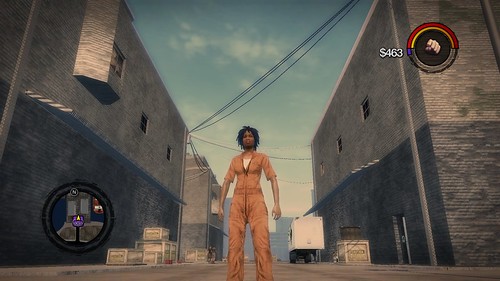
I suppose that the first thing to note is that, yes, SR2 can be a lot of fun - at least on occasion. As it goes to great length to note in adverts, SR2 avoids the slower, "character-forming" concepts that dogged GTA IV, and focuses entirely on frenetic activities and missions. Some of these are very familiar from GTA, but there are number of more unusual tasks, of which personal injury fraud and so-called "toxic avenger" are particular highlights. The former has you instigating "accidental" self-injury for cash, while the latter has you spraying sewage over more salubrious districts of Stilwater in either an act of revenge or to reduce local property values.

However, for all the fun to be had in Stilwater, SR2 is seriously hamstrung on a number of counts. Never fatally to be fair, but enough that the idea that this game is superior to GTA (and, especially, GTA IV) rings pretty hollow. First of all, and unforgivably, in generating the player's immediate environment SR2 has a memory that makes a goldfish's seem immeasurably long. Turn your back for a moment and cars or pedestrians just metres away completely vanish, only to be replaced by fresh NPCs when you turn back. The game does remember when a NPC is chasing you (at least for a slightly greater distance), but its amnesia the rest of the time is a jarring feature of life in Stilwater. And completely unnecessary - while the same is also true in other sandpit games, but they've the good grace to remember nearby NPCs until they at least reach the fringe of draw distance.
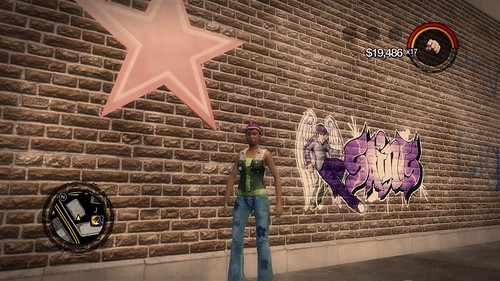
Secondly, in jettisoning anything "slow" and focusing solely on action, SR2 short-changes anyone looking for a more meaningful gaming experience. Characters and story are streamlined to the point that they're practically irrelevant. It would almost make more sense to just present the player with one mission after another on a conveyor belt, and skip anything that gave the game any semblance of coherence or meaning. Everyone that the PC meets is a cardboard cut-out of a two-dimensional stereotype, and NPCs serve only as easily killed impediments to progress, or occasional "friendlies" that seemingly exist just to get in the way. While NPCs in GTA IV often introduced tiresome hurdles to clear, they were also fleshed out to a degree that made me take them as seriously as I would a character in a film or a book. To wit, I was genuinely shocked when a decision I made towards the end of GTA IV backfired and led to the death of a NPC I'd spent hours "getting to know". No chance of that here.
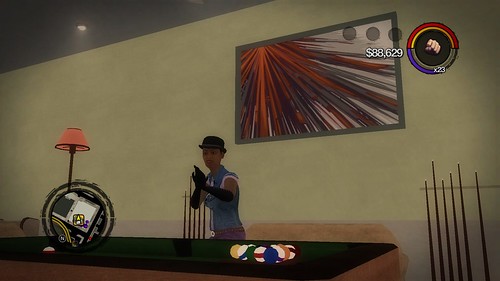
Overall, while SR2 was well worth the £3.73 that I paid for it (thanks Amazon), it's a pale imitation of even early GTA titles. It does often look quite good, there are a lot of fun activities to partake of, and it is occasionally very funny (in particular, the taunts that can be selected for the PC). But it's just not in the same class as its rivals, neither technically nor artistically. I don't think I'll be checking out SR3 should it ever appear.
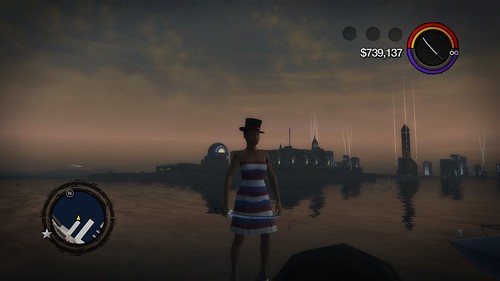
One aspect of SR2 that I did quite enjoy messing with was my PC's attire. In what was akin to dressing up a rather foul-mouthed doll, I managed to give her some pretty odd costumes, as the images here show. More, as ever, over at Flickr.
Set in the fictional American city of Stilwater, SR2 is centred around the rise of the Saints, a criminal gang run by the player character (PC) and his (or possibly her; see screenshots) chum Johnny. Things start from a rather lowly position, with the PC recovering from a Saints Row 1-induced coma, and Johnny needing breaking out of jail. But it's not long before all sorts of GTA-themed mayhem is taking place involving turf wars in Stilwater and reputation-boosting criminal enterprises. The former take place against a heavily stereotyped triumvirate of yardie, yakuza and white-trash gangs, while the latter involve a diverse, and occasionally imaginative, range of property and personal crimes. Eventually, the Saints squeeze out the other gangs only to run up against Ultor, a monolithic corporation that has hitherto secretly been turning the gangs against one another, and is now keen to cash-in on a relatively crime-free Stilwater. Needless to say, the PC steps up to the plate and single-handedly returns the city to its rightful heirs, the Saints.

I suppose that the first thing to note is that, yes, SR2 can be a lot of fun - at least on occasion. As it goes to great length to note in adverts, SR2 avoids the slower, "character-forming" concepts that dogged GTA IV, and focuses entirely on frenetic activities and missions. Some of these are very familiar from GTA, but there are number of more unusual tasks, of which personal injury fraud and so-called "toxic avenger" are particular highlights. The former has you instigating "accidental" self-injury for cash, while the latter has you spraying sewage over more salubrious districts of Stilwater in either an act of revenge or to reduce local property values.

However, for all the fun to be had in Stilwater, SR2 is seriously hamstrung on a number of counts. Never fatally to be fair, but enough that the idea that this game is superior to GTA (and, especially, GTA IV) rings pretty hollow. First of all, and unforgivably, in generating the player's immediate environment SR2 has a memory that makes a goldfish's seem immeasurably long. Turn your back for a moment and cars or pedestrians just metres away completely vanish, only to be replaced by fresh NPCs when you turn back. The game does remember when a NPC is chasing you (at least for a slightly greater distance), but its amnesia the rest of the time is a jarring feature of life in Stilwater. And completely unnecessary - while the same is also true in other sandpit games, but they've the good grace to remember nearby NPCs until they at least reach the fringe of draw distance.

Secondly, in jettisoning anything "slow" and focusing solely on action, SR2 short-changes anyone looking for a more meaningful gaming experience. Characters and story are streamlined to the point that they're practically irrelevant. It would almost make more sense to just present the player with one mission after another on a conveyor belt, and skip anything that gave the game any semblance of coherence or meaning. Everyone that the PC meets is a cardboard cut-out of a two-dimensional stereotype, and NPCs serve only as easily killed impediments to progress, or occasional "friendlies" that seemingly exist just to get in the way. While NPCs in GTA IV often introduced tiresome hurdles to clear, they were also fleshed out to a degree that made me take them as seriously as I would a character in a film or a book. To wit, I was genuinely shocked when a decision I made towards the end of GTA IV backfired and led to the death of a NPC I'd spent hours "getting to know". No chance of that here.

Overall, while SR2 was well worth the £3.73 that I paid for it (thanks Amazon), it's a pale imitation of even early GTA titles. It does often look quite good, there are a lot of fun activities to partake of, and it is occasionally very funny (in particular, the taunts that can be selected for the PC). But it's just not in the same class as its rivals, neither technically nor artistically. I don't think I'll be checking out SR3 should it ever appear.

One aspect of SR2 that I did quite enjoy messing with was my PC's attire. In what was akin to dressing up a rather foul-mouthed doll, I managed to give her some pretty odd costumes, as the images here show. More, as ever, over at Flickr.
Monday 3 January 2011
Scientific aesthetics
As a modeller, numbers are (largely) the be-all and end-all of my scientific life, and I spend much of my time trying to interpret the quantitative output from the various models that I use. A big part of this (and the root of my love for Matlab) is making figures and diagrams to tease out what's going on, so I've been watching the Beeb's (recently finished) series, The Beauty of Diagrams, with great interest.
In its six programme run, it's taken in: da Vinci's Vetruvian Man; Copernicus' heliocentric solar system; Newton's prism refraction; Nightingale's polar area mortality charts; Watson and Crick's DNA helix; and the Pioneer 10 plaque designed by Sagan and Drake. Intriguingly, the latter two diagrams were both drawn by the wives of male scientists involved.
Anyway, on the whole the series was quite a gem. I'm not usually Marcus du Sautoy's biggest fan, his mathematical programmes being a little too dry for me, but he (or perhaps the series' writers) did a good job picking the diagrams and fleshing out both their immediate histories and why they were so significant. It did come a little unstuck in the DNA programme, which dealt rather too much with non-scientific appropriations of the double helix, but overall was an excellent idea, well-executed.
My favourite, and the most "outlying" of the diagrams, was the final programme on the Pioneer 10 plaque. While the other diagrams were largely aimed at exposition of some novel scientific idea (though da Vinci's Vetruvian Man has an additional aesthetic appeal), the diagram on the plaque serves a very different purpose. It does, to be sure, communicate some scientific ideas, but only enough to convey a few practical details about humans and the location of Earth in the galaxy.
Instead, journeying on a one-way ticket out of the solar system, and destined to voyage for an almost unimaginable period of time before it reaches even the next star, the plaque is really more about putting down a marker for humanity, "We were here!". As such, it touches on things more inspirational, taps into deeper considerations of how we view our place in the universe, and seems an altogether more hopeful scientific diagram. Not the kind that plankton modelling is ever likely to require, but something very close to the heart, rather than the mind, of scientific endeavour (if one can get all pretentious about it).
In its six programme run, it's taken in: da Vinci's Vetruvian Man; Copernicus' heliocentric solar system; Newton's prism refraction; Nightingale's polar area mortality charts; Watson and Crick's DNA helix; and the Pioneer 10 plaque designed by Sagan and Drake. Intriguingly, the latter two diagrams were both drawn by the wives of male scientists involved.
Anyway, on the whole the series was quite a gem. I'm not usually Marcus du Sautoy's biggest fan, his mathematical programmes being a little too dry for me, but he (or perhaps the series' writers) did a good job picking the diagrams and fleshing out both their immediate histories and why they were so significant. It did come a little unstuck in the DNA programme, which dealt rather too much with non-scientific appropriations of the double helix, but overall was an excellent idea, well-executed.
My favourite, and the most "outlying" of the diagrams, was the final programme on the Pioneer 10 plaque. While the other diagrams were largely aimed at exposition of some novel scientific idea (though da Vinci's Vetruvian Man has an additional aesthetic appeal), the diagram on the plaque serves a very different purpose. It does, to be sure, communicate some scientific ideas, but only enough to convey a few practical details about humans and the location of Earth in the galaxy.
Instead, journeying on a one-way ticket out of the solar system, and destined to voyage for an almost unimaginable period of time before it reaches even the next star, the plaque is really more about putting down a marker for humanity, "We were here!". As such, it touches on things more inspirational, taps into deeper considerations of how we view our place in the universe, and seems an altogether more hopeful scientific diagram. Not the kind that plankton modelling is ever likely to require, but something very close to the heart, rather than the mind, of scientific endeavour (if one can get all pretentious about it).
Sunday 2 January 2011
Biomodelling

Finally got around to sorting out the photographs from 2010's Biomodelling Christmas Lunch. Unfortunately, an inexplicably low ISO setting left quite a few heavily blurred, and this was followed by the camera's flash bulb giving up the ghost while the night was still young. So something of slim pickings this year, though there were a few good ones along the way ...
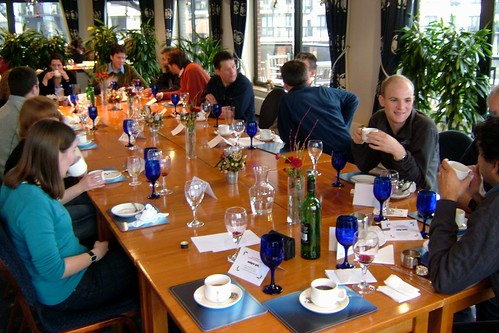
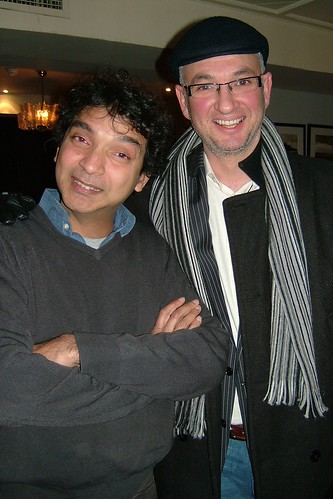
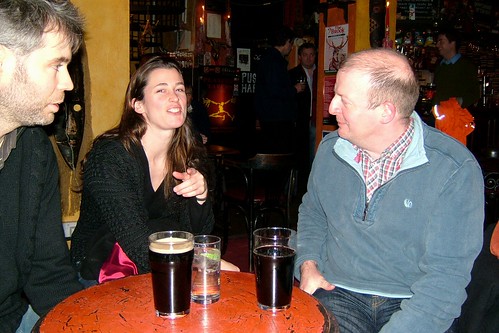
More photos over at Flickr.
Anyway, the meal went pretty well again this year. Better, in fact, than other years I'd say. So we might well wind up back at the RSYC later this year. That said, I think I may try to delegate organising to someone else next time though. It's not exactly a big deal to sort out, but I've probably served my time by now - not least because I've been conservatively sticking to the same formula for years.
In other news, and cf. an earlier posting, we did shamble onto the usual territory when we were all slightly the worse for wear. Not my doing this time, but APM and BS were keen to rabble-rouse for their side of the argument. I don't think that they won many converts, in fact if anything they seemed to stir natural allies against them, but critical thinking skills were probably not at their sharpest then.
I wound up at the periphery of the discussion debating (with the BAG man) whether the "free will" I'm interested in is more or less important than a sociological definition concerning the opportunities available to less fortunate members of society. That was fun, though I seem to recall that we drifted markedly, and that I wound up in full misanthrope mode and bemoaning the fate of the environment. Fun, fun, fun.
Saturday 1 January 2011
No Revelations
It's 2011 now, but I've a stack of books to write-up from 2010. This is going to be a little cursory, but here goes anyway. First up is a short story collection from blog-favourite, Alastair Reynolds. Not from his Revelation Space series this time, but a series of stories from across his career, 1991 through to 2008, Zima Blue.
Unlike earlier collections, this one is largely made up of discrete stories that aren't united in a common universe, though there are a few that share the same future and a few characters. Considering that Reynolds is probably most famous for his interstellar Space Operas, most of the stories are rather surprisingly low-key, with some even taking place within a recognisable (and very British) near-future.
They range across hopeful post-apocalyptic yarns (Enola); Martian sloths (The Real Story); galactic journeys gone wrong (Beyond the Aquila Rift); explorations of many worlds in Wales (Signal to Noise); an investigation of space-time accompanied by an Elton John AI (Understanding Space and Time); and quantum immortality (Everlasting).
My favourite was the eponymous story, Zima Blue (obviously), which concerns a planetary-scale artist, Zima; the shade of blue that his work utilises; and how he gradually remembers the origin for this aesthetic preference. Which probably makes it sound ridiculous or seriously boring, but I felt that it had some real existential heart. It also pleasingly reminded me of the French artist, Yves Klein, whose rather vivid work we first came across in Barcelona (or was it Nice?), and who invented a particular shade of blue that features prominently in his work. I imagine that Reynolds must also be a fan.
Anyway, while there were one or two stories I was left scratching my head at the end of ("is that it?"), most were really quite good. As well as Zima Blue, I particularly liked Aquila Rift's premise of a routine space voyage gone vastly and terrifyingly wrong, and its introduction of an alien Samaritan picking up the pieces. Reynolds' "many worlds in Wales" tales were really nicely thought through too (a strange fusion between the corresponding works of Greg Egan and Iain Banks), though the Welsh setting made them seem rather mundane to me. It's probably true for other people too, but I tend to be aesthetically prejudiced against UK-set science fiction. It needs to be set somewhere "exciting" and "exotic", like Los Angeles ...
Overall, more solid fare from Reynolds. I'm already looking forwards to getting back to him before too long courtesy of a recent present from C: Terminal World.
Unlike earlier collections, this one is largely made up of discrete stories that aren't united in a common universe, though there are a few that share the same future and a few characters. Considering that Reynolds is probably most famous for his interstellar Space Operas, most of the stories are rather surprisingly low-key, with some even taking place within a recognisable (and very British) near-future.
They range across hopeful post-apocalyptic yarns (Enola); Martian sloths (The Real Story); galactic journeys gone wrong (Beyond the Aquila Rift); explorations of many worlds in Wales (Signal to Noise); an investigation of space-time accompanied by an Elton John AI (Understanding Space and Time); and quantum immortality (Everlasting).
My favourite was the eponymous story, Zima Blue (obviously), which concerns a planetary-scale artist, Zima; the shade of blue that his work utilises; and how he gradually remembers the origin for this aesthetic preference. Which probably makes it sound ridiculous or seriously boring, but I felt that it had some real existential heart. It also pleasingly reminded me of the French artist, Yves Klein, whose rather vivid work we first came across in Barcelona (or was it Nice?), and who invented a particular shade of blue that features prominently in his work. I imagine that Reynolds must also be a fan.
Anyway, while there were one or two stories I was left scratching my head at the end of ("is that it?"), most were really quite good. As well as Zima Blue, I particularly liked Aquila Rift's premise of a routine space voyage gone vastly and terrifyingly wrong, and its introduction of an alien Samaritan picking up the pieces. Reynolds' "many worlds in Wales" tales were really nicely thought through too (a strange fusion between the corresponding works of Greg Egan and Iain Banks), though the Welsh setting made them seem rather mundane to me. It's probably true for other people too, but I tend to be aesthetically prejudiced against UK-set science fiction. It needs to be set somewhere "exciting" and "exotic", like Los Angeles ...
Overall, more solid fare from Reynolds. I'm already looking forwards to getting back to him before too long courtesy of a recent present from C: Terminal World.
Labels:
Alastair Reynolds,
book,
present,
science fiction,
short story
Subscribe to:
Posts (Atom)

